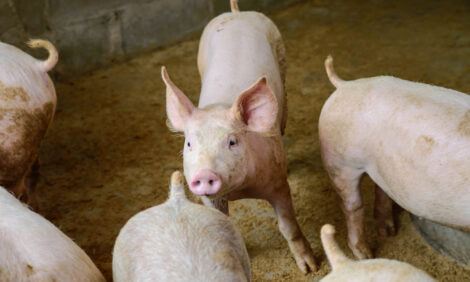In pig feed, GMO and conventional corn perform same
NEBRASKA - When it comes to pig feed, there’s no difference between genetically modified and conventional corn, University of Nebraska research shows.
|
Need a Product or service?
|
|
 Phil Miller, swine nutritionist, and animal science graduate students compared pig growth and percent lean in pigs fed Bt corn for rootworms or conventional corn. In another study, they compared nutritional value and nitrogen digestibility for young pigs fed Roundup Ready corn and those fed conventional corn.
Phil Miller, swine nutritionist, and animal science graduate students compared pig growth and percent lean in pigs fed Bt corn for rootworms or conventional corn. In another study, they compared nutritional value and nitrogen digestibility for young pigs fed Roundup Ready corn and those fed conventional corn.
Neither study revealed significant differences, Miller said. Pigs fed genetically modified corn perform as well as those fed conventional corn.
As more acres are planted to genetically engineered crops, livestock producers want to know the feed value of genetically modified grains. “As a scientist, it’s easy to say there shouldn’t be any differences between genetically modified corn and non-genetically modified corn, but we need to demonstrate that to the general public,“ he said.
 Researchers evaluated 72 barrows and 72 gilts for the Bt study. Pigs were weighed and feed intakes were measured biweekly to determine average daily gain, average daily feed intake and feed efficiency. After slaughter, backfat depth and carcass traits were measured.
Researchers evaluated 72 barrows and 72 gilts for the Bt study. Pigs were weighed and feed intakes were measured biweekly to determine average daily gain, average daily feed intake and feed efficiency. After slaughter, backfat depth and carcass traits were measured.
Results showed Bt corn does not affect pig performance. There were statistical differences between the sexes, but that is typical because gilts grow slower and are leaner than barrows, Miller said. For the Roundup Ready study, the Institute of Agriculture and Natural Resources team evaluated 12 barrows fed twice daily for 14 days. Researchers analyzed urine and fecal samples.
Results showed dry matter, crude protein and energy density were similar for the two corn varieties. Roundup Ready corn can be fed to young pigs without hurting nitrogen or energy digestibility, Miller said.
Source: Sandi S. Alswager, Research Nebraska Magazine - University of Nebraska, Lincoln - 13th November 2003




 Phil Miller, swine nutritionist, and animal science graduate students compared pig growth and percent lean in pigs fed Bt corn for rootworms or conventional corn. In another study, they compared nutritional value and nitrogen digestibility for young pigs fed Roundup Ready corn and those fed conventional corn.
Phil Miller, swine nutritionist, and animal science graduate students compared pig growth and percent lean in pigs fed Bt corn for rootworms or conventional corn. In another study, they compared nutritional value and nitrogen digestibility for young pigs fed Roundup Ready corn and those fed conventional corn.
 Researchers evaluated 72 barrows and 72 gilts for the Bt study. Pigs were weighed and feed intakes were measured biweekly to determine average daily gain, average daily feed intake and feed efficiency. After slaughter, backfat depth and carcass traits were measured.
Researchers evaluated 72 barrows and 72 gilts for the Bt study. Pigs were weighed and feed intakes were measured biweekly to determine average daily gain, average daily feed intake and feed efficiency. After slaughter, backfat depth and carcass traits were measured.













